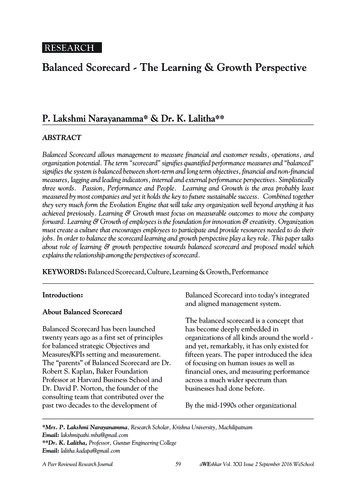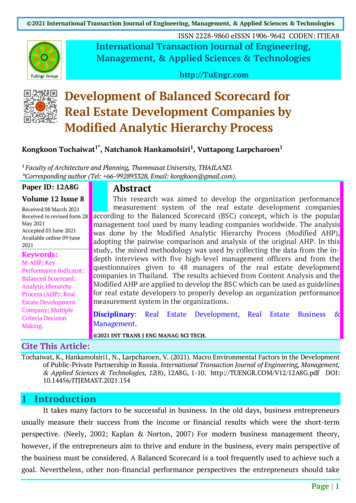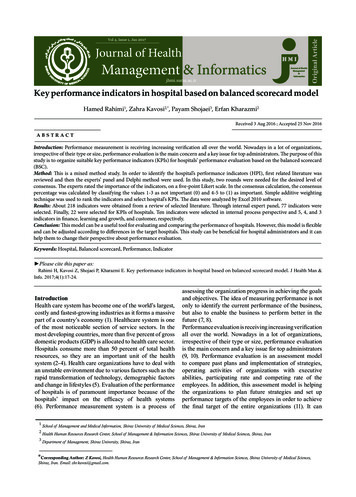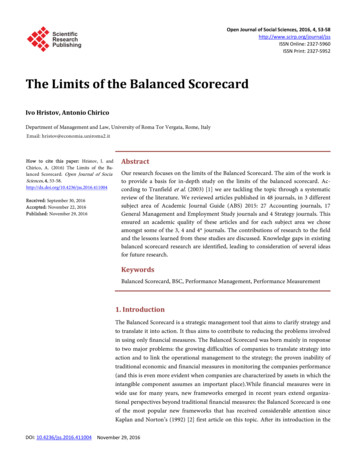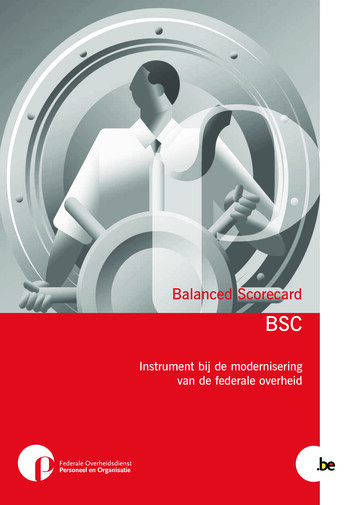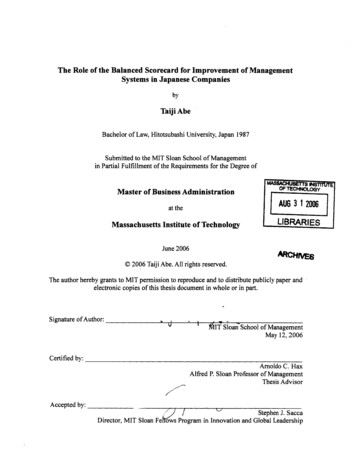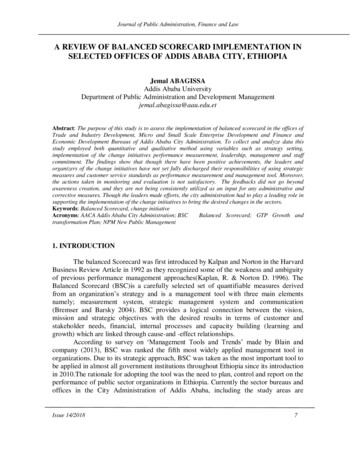
Transcription
A BALANCED SCORECARD (BSC) FORIT PERFORMANCE MANAGEMENTBrian WattsSAS Institute AustraliaThe Information Age has brought with it an increased dependence upon the value ofintangible assets such as knowledge, yet the value of Information Technology hastraditionally been measured from a cost-centred, financial performance perspective.Deriving performance measures that link intangible asset value to financial outcomesprovides the kind of balanced performance feedback the planning process requires in theInformation Age. This paper is a presentation and extension of contemporary works byvarious authors referenced.1INTRODUCTIONThe objective of this paper is to identify thesuitability of the Balanced Scorecard (BSC), asformalised by Robert Kaplan and David Norton,for Information Technology (IT) performancemeasurement and LREPORTING INADEQUATEIt has become widely accepted that the focus oftraditional financial reporting is no longerrelevant for the post-industrial age (Morrow1992, Johnson and Kaplan 1987, Drucker 1995).Traditional financial measures assess pastperformance. They can tell you how muchfinancial value has been attained. They cannottell you how much value will be attained becausethey do not recognise the drivers of futureperformance. Financial measures are assessed ata point in time when the non-financial links inthe value chain have already run their course todeliver the financial outcome.The information age has seen a migration fromproduction to service and knowledge-orientedindustries and an increasing strategic importanceof information technology to business.As customer service increases and unitproduction costs decrease, the human resourcesoverhead will increase. This renders traditionalmanufacturing costing methods incomplete. Toquote Johnson and Kaplan (1987), “today’smanagement accounting information, , is toolate, too aggregated and too distorted to berelevant for manager’s planning and controldecisions”.Drucker (1995) suggests that the entireeconomic value chain must be costed in order toprovide effective analysis of costs. Furthermore,as more companies depend on human resourcesfor customer service, product innovation andknowledge, the importance of implementing andmanaging effective human resource policiesgrows accordingly.2.1Knowledge industriesThe advent of knowledge-based industries, suchas Information Technology, have placedconsiderable importance on employees andknowledge. High research and developmentcosts are not unusual (between 20% to 30% ofannual revenues). This level of innovation,generated through human knowledge, highlightsthe importance of effective human resourcepolicies in order to ensure a highly motivatedworkforce.While the treatment of human resources asintellectual capital in organisations is yet to bewidely understood and adopted, there has been agrowing trend to develop models to address thisneed. Letza et al (1997) list a number ofcorporate performance management frameworkseach of which include financial and nonfinancial indicators.Kaplan and Norton (1996) formalised theBalanced Scorecard which complementsfinancial indicators with three categories of nonfinancial indicators.In 1987 a Swedish working group developed theKonrad Theory (Konrad Group 1987). This ledto the development of the Intangible AssetsMonitor (IAM) (Sveiby, 1997).In "The New Organisational Wealth" by.com.au/) Sveiby discusses thetreatment of software and IT people as "addedvalue" and outlines ways to measure intellectualcapital. Sveiby argues that in a knowledgeCopyright for this paper remains solely with the author. The author grants specific permission to CMG Australia to publish thispaper as part of the CMGA Conference Proceedings/Journal, and electronically via the US CMG Proceedings CD ROM and CMGAustralia’s World Wide Web Site.
Brian Watts: Balanced Scorecardeconomy people should not be regarded as costs,but rather revenue creators and that knowledgeor people's competence are sources of wealthcreation.Information age based thinking of this type isvery good news for IT departments and workerswho instinctively know that they do not fit thecost accounting model yet find themselvesplaced into it.2.2Problems faced by IT uniqueto the information age.Specifically, the following areas of importanceare affecting IT business: The conflict of industrial age based measuresand their inadequacy for information ageproductivity. Management of human resources to retainintellectual capital within the company. Escalating cost of human resources inproduction, and in service delivery. Increasing software maintenance and licensecosts in line with cost of human resources. Increasing demand for customer satisfaction.A good example of the influence of industrial vsinformation age thinking is revealed in attitudesto IT project management. According to RobThomsett, of "The Thomsett Company, ProjectManagement":"Project teams have always been different to process teamsbut, with the exception of pioneering work in the 1970's byGerry Weinberg, Larry Constantine and our group, projectteams have generally been ignored by mainstreamorganisation and management gurus. Most managementexperts either ignore project teams or focus on processteams or, alternatively, confuse both types of teams as thesame team type". (Thomsett)Process vs Project - Exact OppositesProcess Work it is predictable; it maintains the statusquo of organisationalprocesses.it repeats;it is standardised;it takes a short time toconclude;Project Work it is un-predictable; it changes the status quo oforganisational processes.it is unique;it is difficult to standardise;it takes a long time toconclude;Table 1: adapted from Rob Thomsett'spresentation at the AmericanProgrammer Summit in Boston early1999 on the phenomenon of 'The VirtualTeam':Knowledge workers such as IT workers aregenerally involved in project work. Knowledgework is a creative undertaking, which has all thehallmarks of project work.You can imagine, for example, the potentialfrustration of expecting a process-based estimatefrom a project-based task. The process workermerely has to look at past requirements andresults to estimate confidently how long it willtake next time. A project worker however isfacing a unique set of variables and needs farmore detail of present and future possibilities toderive a proper estimate. Project estimates tendto be an educated guess, the accuracy of whichimproves in direct proportion to the amount oftime between the request for the estimate andreceiving of the answer.Just as traditional accounting measures do notadequately value the intangible assets of theinformation age, process based work measuresare inadequate for the unique nature of ITknowledge work.The challenge for IT is to derive measures totrack their intellectual capital investments inorder to manage that value for future profit.Without such measures the loss or underutilisation of intellectual capital would remainhidden.3TRACKINGINFORMATIONTECHNOLOGY VALUEThe Kaplan and Norton BSC is a model thatoffers a means to lift non-financial ratios andindicators from the operational to the strategiclevel of the firm. The IAM model as supportedby Sveiby offers a more detailed means to trackknowledge industry specific intangible assets.The use of such models may offer new "best-ofbreed" methods for tracking and managing thevalue of IT to business. Adding measures for thenon-financial links in the value chain may helpIT to: Properly assess the performance and value ofintangible, non-financial, assets, and thusprotect the "investments in the capabilitiesthat provide value for the future" (Kaplanand Norton 1996, p18, 23). Assist management to link the intangible,non-financial, IT drivers of business value tospecific financial outcomes. Provide early warning indicators when thoseintangible, non-financial, IT drivers reveal atrend which could negatively impact financialoutcomes. To guide and improve strategic planningprocesses and decisions as a result offeedback on the performance of IT drivers ofbusiness excellence. Track the measures for these IT drivers overa period of time. Such a performance
Brian Watts: Balanced Scorecarddatabase could then provide current andhistorical performance analysis and trending. Assist management to more accuratelypredict the impact of proposed changes anddecisions by having access to historical dataand trends. Have ready information to support businesscases, allocate resources, justify expenditure,and prioritise efforts. Better understand the impact of localdecisions and effort on the corporate bottomline. Open the possibly for profitable opportunitiesto be revealed which could then be nurturedand supported.The construction of measurement models totrack intangible assets thus becomes a keyelement in a value-based IT strategy that aims toimprove the image, relevance and relationshipbetween IT and corporate business.4THEBALANCEDSCORECARD: THEORETICALCONCEPTSThe key objective for an IT Balanced Scorecardis to communicate the business value of IT to thewhole organisation. To succeed in this IT needsto create effective tools for the management andgrowth of intellectual capital.IT is core strategic business and requires nontraditional performance measures to track thenon-financial value that is core to theinformation age. The goal is to proactively setthe standard for measurement of IT performance.In this way IT can avoid dependence uponmeasures that undervalue the contribution of ITto financial outcomes.The following will outline the main elements ofthe Balanced Scorecard concept, drawingheavily from Kaplan and Norton (1996). Thenext section will adapt these elements andsuggest ways to build a Balanced Scorecard forIT performance management.4.1The Theory of the BalancedScorecardThe Balanced Scorecard is intended to be usedto communicate strategic direction and scoreperformance to help motivate and align.The BSC focuses on four key perspectives ofbusiness, as shown in Figure 1 below. The goalis to then develop strategic focus points andgeneric measures relevant to IT. Typically onewould ensure that they are aligned with thecorporate strategy. Managers will need toidentify “cause” and “effect” measures, and thedrivers that affect these metrics, in order to gainthe full benefit of the scorecard in settingrelationship between IT value and corporateactivities. The importance of establishing theserelationships is discussed in Kaplan and Norton,1996, p30-31.PerspectiveFinanceStrategic FocusHow must wemeet targets?CustomerHow shouldwe appear tocustomers?BusinessProcessWhich processto optimise andwhich ones toinnovate?Learning/GrowthHow do wesustain ourability tochange andimprove? Howdo we manageour intellectualcapital?Generic Measures Return on investmentAsset utilisationBudget costsEconomic value addedCustomer satisfactionCustomer retentionNew customersCustomer profitabilityMarket shareQualityResponse timeCostNewproductintroductionEmployee satisfactionTraining effectivenessSupport of innovationFringe e 1: The key perspectives of theBalanced ScorecardSource: Adapted by Ansfield (1997)from Kaplan and Norton, 1996, p.9, 444.1.1FINANCIAL PERSPECTIVEFinancial measures represent the goal of theorganisation. In most public companies, thebasic underlying measure is “return oninvestment”. Other measures, such asprofitability, cash flows, liquidity and gearingare all financial measures which may appear inthe scorecard. This perspective reinforces themain ethos of business - financial growth.The BSC retains the financial perspective as thegoal of the non-financial measures, and throughanalysis of the cause and effect relationshipsestablishes the means to ensure that the financialbenefits are realised.The irony is that spending cutbacks on nonfinancial assets would be reported as increasedincome under a financial accounting model(Kaplan and Norton, 1996, p23) even though itmay leave a company weak in its capabilities forcreating future economic value. However undera Balanced Scorecard such cutbacks would berevealed as loss of corporate value.
Brian Watts: Balanced Scorecard4.1.2CUSTOMER PERSPECTIVEIn the customer perspective, the companyidentifies the market areas and product segmentsin which the company wishes to compete. Basedon those segments, the company can set targetsfor the core elements of customer management:acquisition, profitability and retention. Theseelements form the basis of effective customerrelationship management. It is only throughthese measures that companies can effectivelymeasure and manage the profitability of theircustomer segments (Shapiro, Slywotzky andDoyle 1997).4.1.3BUSINESS PROCESSPERSPECTIVEThe business process perspective takes aninternal view of an organisation’s ability forinnovative development, production and theintroduction of new products to market. It isimportant for the organisation to understand theinternal value-process, in order to identify whereand how process improvement must occur. Intoday’s competitive markets, the continuousimprovement of internal processes is critical inconsistently and constantly meeting TIVEFinally, the learning/growth perspective focuseson the human aspect of corporate management.Employee satisfaction is strongly linked withknowing the role they play in an organisationssuccess. If not provided with that information, ITworkers would tend to focus on technical orprofessional excellence without ever knowing iftheir efforts actually contributed to the financialbottom line (Thomsett). The human element iscritical to the focussed success of theorganisation.It is well recognised that employee satisfaction isdirectly correlated to productivity, and thereforeprofitability. Because metrics for a BalancedScorecard are developed through cause-andeffect analysis to link them to the strategic plan,it provides a means to enable employees tounderstand their specific role in the success ofthat plan.Furthermore, organisations must learn to retainand exploit knowledge, in order to be morecompetitive. This concept has been explored bySenge (1990) and Sveiby (1997), amongstothers.4.1.5PUTTING THEM TOGETHEROne of the key concepts of the BSC is the ideaof “driver” and “result” metrics. “Driver”indicators are those indicators, which reflectupcoming change. “Result” indicators are thosewhich show that the change has in facthappened. The aim is to build “driver” indicatorsinto the scorecard, so that the scorecard will actas an early warning system for the “result”indicators. One issue here, however, is that the“driver” indicators which indicate an impendingperformance change will only be reflected in alater accounting period. Kaplan and Norton(1996) refer to “lead” and “lag” indicators forthis concept. The concept of “driver” and“result” is a more intuitive description.One other important point in the development ofBSC is the number of metrics that should beincluded. Kaplan and Norton (1996) suggest thatthere should be a maximum of 4 measures perperspective, in order to ensure that an overviewis maintained. Considering that strategy oftenchanges with changing circumstances, it issensible to keep diagnostic measures to aminimum so as to reduce maintenance.While organisations will undoubtedly have anumber of detailed diagnostic measures, in orderto maintain a high-level overview of theorganisation, these should not be included in thescorecard. One solution to this is the IAM basedon the Konrad Theory (Sveiby, 1997). The IAMtakes a more detailed view of knowledge with a16 element matrix. A successful strategy formanaging the knowledge based intangible assetsof IT may well incorporate an IAM model as thebasis for the 4 measures used in the BSC.4.1.6LINKING STRATEGY TO THEBALANCED SCORECARDSimons and Mintzberg (1995 and 1990) haveidentified the following key reasons whyorganisations must respond to the businessenvironment faster than ever before, and why thelearning organisation is so important. Strategies are incremental, and will changeover time. Designed strategies can be superseded in ashort period of time. In the empowered organisation, strategicideas will develop at all levels.The development of the scorecard concept as apart of the planning process allows managementto monitor, measure and motivate theorganisation. Furthermore, the following benefitscan be achieved: The process of developing the scorecard,using the framework described below, brings
Brian Watts: Balanced Scorecardclarity and consensus to the decision-makingprocess. The top-down approach of the scorecardenables clear targets to be set for individualinitiatives within business units. The concise nature of the scorecard enablesmanagers to effectively communicate strategythroughout the organisation.Using the framework shown in Figure 2,managers can evaluate the critical factors for thebusiness and generate initiatives to achieve thosefactors, leading to the measures and linkagesrequired for the BSC.Figure 2: From Corporate Vision toPerformance MeasurementCorporate VisionWhat is our corporatevision of the future?FinancialCustomerPerspective PerspectiveTo reach our vision, howmust we differentiate?What are the criticalsuccess factors in orderto achieve our vision?What initiatives arerequired to achievecritical success factors?What metrics arerequired to rocessesWith internalprocessesLearning/GrowthWith theability to --------------------------------------The Balanced ScorecardSource: Kaplan & Norton (1993), p. 139.With the ability to measure the key performanceindicators of the organisation, behaviour can bemodified to improve results.The ability to modify behaviour, norms and rulesbased on understanding is referred to as “doubleloop” learning. Senge (1990) suggested thatmost organisations were not effective at this typeof learning.The “cause” and “effect” indicators of thescorecard will, however, enable this type oflearning to occur. Having made strategicdecisions, it will become apparent to managersin a short period of time what effect thesestrategies will have on business results.A number of other corporate performancemanagement frameworks, each of which includefinancial and non-financial indicators, is listedby Letza et al (1997). However, the BSC hasgained acceptance mainly due to its simplicityand applicability to many industry sectors. It is,however, important to highlight that thescorecard is a framework to aid strategyplanning and review and not just a reportingsystem.5IAM AS AN IT KNOWLEDGECOMPLEMENT TO BSCSveiby takes the view that the BSC can still beseen as rooted in industrial age thinking byvirtue that it takes existing organisation theoryfor granted, and just adds non-financial measuresto the traditional financial indicators. Hebelieves that the BSC still regards people ascosts rather than revenue creators.IAM on the other hand is based on the notion ofpeople as an organisation's only profitgenerators, and that indicators should bedeveloped from the premise that an organisationis a knowledge organisation. The process thenbegins by identifying what outcome yourcustomers achieve from the knowledge ).For the purposes of developing a BSC for ITmanagement, it is worth being aware of theprinciples of the IAM due to its knowledgeindustry based focus.If one developed an IAM to satisfy the need fora more knowledge focussed view of IT, then itwould be a fairly simple step to determine whichof those measures should flow into a BSC.The ongoing purpose of the IAM would be toprovide a more detailed history of the growth,renewal and utilisation of intangible assets suchas intellectual capital, and to be better able toassess the risk of losing it.The BSC could then provide the means to addthe balance of non-financial indicators toexisting financial indicators. The IAM wouldprovide IT with a far more coherentunderstanding of IT value drivers. This wouldallow the substantiated selection of the BSCmeasures that best represent IT interests.6DESIGNING A BALANCEDSCORECARD FOR ITWithout doubt the hardest part of this process forIT is the part which requires thinking,developing appropriate objectives for each set of
Brian Watts: Balanced Scorecardindicator, and then deriving the best indicators tomeet those objectives.The following examples are intended more to bean indication of the types of measures one couldinclude in a possible BSC for IT. They areadapted from ideas from Ridgley 1999 andAnsfield 1997. Sveiby provides a thoroughtreatment of the IAM, with excellent examples,some of which are also adaptable to a BSC,others of which provide a richer level of detailmore suited to an IAM.To develop good measures, the general processis to first be clear about the high level objectivesyou wish to attain, and then iteratively developmore detail on how to achieve them. Thisprocess is what the examples in section 6.1 and6.2 are attempting to illustrate.6.1 KeyobjectivesScorecards:of6.2.1 ITTo provide a method for communicating thevalue of IT knowledge to corporatebusiness.To provide a history of indicators thatrepresent the growth, renewal and utilisationof IT knowledge. 6.2 The Four BSC MetricsFinancial: (How must, we meet targets?)Return on investment, Asset utilisation,Budget costs/actuals, Economic valueAdded (EVA), Return on Investment (ROI),Capacity planned cost, Chargeback income.Customers: (How should we appear tocustomers?)Customer satisfaction, Customer retention,New customers, Customer profitability,Market share, Quality agreement attainment,Function point delivery.Internal Process: (Which process tooptimise and which ones to innovate?)Quality, Response time, Cost, New productintroduction, Metrics from Service le, Innovation and Learning: (How dowe sustain our ability to change andimprove? How do we manage ourintellectual s, Support of innovation, Fringebenefits, Recognition, Flexibility of workpracticesRatio of IT costs to total corporate costs.Percent of total IT spending on corebusiness initiatives.Ratio of IT spending on core businessinitiatives to IT payroll.Ratio of estimated project expenses toactual expenses.Ratio of business case benefits estimated toactual benefits realised.6.2.2 CUSTOMER PERSPECTIVEMETRICSChange in profile of best customers, egthose using above 75th percentile of cpu orservices, top n mission critical applicationowners, customers that use new technologythat IT wish to learn and encourage the useof, customers that raise profile and image ofIT.Customer satisfaction with delivery ofproject benefits.Customer surveys to derive othersatisfaction metrics.Ratio of customer suggestions/requestsmade and number implemented (eg requestsfor availability of new technology).Help desk metrics (satisfaction withsupport/maintenance, queue length).Comparison to industry service standards.Ratio of chargeback/IT costs customer paysto IT to the total customer expense budget.Ratio of chargeback/IT costs customer paysto customer income.6.2.3 FINANCIAL PERSPECTIVEMETRICSINTERNAL PROCESSPERSPECTIVE METRICSRatio of maintenance projects on budget tototal maintenance projectsRatio of maintenance projects to newprojectsCount of production application failures today, week, month, yearComparison of project estimated completionto actual completion datesRatio of investment in IT capacity planningto total IT costs.Number of maintenance employees to totalemployeesRatio of defect count of implementedsoftware product to number of productsinstalled, perhaps by business unit.
Brian Watts: Balanced Scorecard6.2.4 7PEOPLE, INNOVATION ANDLEARNING PERSPECTIVEMETRICSAverage hours per employee by day, week,month, year (mean, mode, median, max,min)Ratio of contract to permanent staffRatio of management staff to total staffRatio of unused skills total staffMonths of experience by years in positionMonths of experience in top n skills usedNumber of external training hours providedper position / skill typeNumber of internal training hours providedper position / skill typeEmployee turnover %Number of restructures/positions rotated permonth, yearSick days taken ytd to number of employeesLeave days taken ytdCONCLUSIONThe BSC offers a means for IT to improvedialogue with corporate business. It does this byrecognising the contribution of non-financial ITvalue to the corporate bottom line. Because nonfinancial indicators provide measures for futurevalue creation, it enables IT to ensure that theirability to create such future value is protectednot lost. The BSC provides an ability tocommunicate IT value in a more persuasivelanguage. Because the BSC tends more towardssatisfying a more traditional financial view ofpeople, knowledge and wealth creation, IT needsto look beyond the BSC.One direction in which IT may look is to toolssuch as the IAM. The objective is to provide aknowledge focussed view of what is happeningin IT departments with measures and languagethat are not influenced by traditional financialmodels for representing value. This may thenprovide the basis for measures best able to serveIT purposes in the BSC. If this is achievedsuccessfully, then IT will have at their disposalpowerful tools to communicate IT valuethroughout the age of information.inspiration, and for references for the topic ofthe BSC for IT management.BUTLER, A., LETZA, S., NEALE, B. (1997),A Case Study of the Development of theBalanced Scorecard, Long Range Planning.DRUCKER, P., (1995), The InformationExecutives Truly Need, Harvard BusinessReview, January-February 1995, pp. 54-62.GRAY, S. (1995), Cultural Perspectives on theMeasurement of Corporate Success, EuropeanManagement Journal, Volume 13, Number 3,1995, pp. 269-275.JOHNSON, H. T., KAPLAN, R. S (1987),Relevance Lost: The Rise and Fall ofManagementAccounting,Boston,Massachusetts: Harvard Business Review Press.KANTER, R.M (1984), Managing the HumanSide of Change, Management Review, April1985, pp. 52- 56.KAPLAN, R. S., and NORTON, D. P. (1993),Putting the Balanced Scorecard to Work,Harvard Business Review, September-October1993, pp. 134-137.KAPLAN, R. S., and NORTON, D. P. (1996),The Balanced Scorecard - Translating Strategyinto Action. Boston, Massachusetts: HarvardBusiness Review Press.LETZA, S., ZAIRI, M. and WHYMARK, J.(1997), TQM - Fad or Tool for SustainableCompetitive Advantage: An Empirical Study ofthe Impact of TQM on Bottom Line BusinessResults, University of Bradford.LETZA, S. (1996), The Design andImplementation of the Balanced BusinessScorecard, Business Process Re-engineering andManagement Journal, Volume 2, No. 3, 1996,pp. 54-76.BIBLIOGRAPHY:MINTZBERG, H. (1987), Crafting Strategy,Harvard Business Review, July-August 1987,pp. 66-75.ANSFIELD, Simon, Business Manager, SystemsDivision, SAS Institute, EMEA, 1997. A specialthank-you and credit is due to Mr. SimonAnsfield for significant structural and contentMINTZBERG, H. (1990), The Design School:Reconsidering the Basic Premises of StrategicManagement, Strategic Management Review,November-December 1990, pp. 171-195.
Brian Watts: Balanced ScorecardMORROW, M. (ed.) (1992), Activity-BasedManagement: New Approaches to MeasuringPerformance and Managing Costs. New York:Woodhead-Faulkner.PETERS, T.J. and WATERMAN, R.H.(1982),In Search of Excellence - Lessons fromAmerica’s Best Run Companies. London:Harper and Row.RIDGLEY, Gail, Senior Systems Engineer,Business Solutions Division, SAS Institute,USA, 1999. A special thank-you and credit isdue to Ms. Gail Ridgley for the majority of theBSC implementation ideas presented in sectionseven.RODGERS, P. (1989), FunctionGuidelines, IBM Internal Document.PointSENGE, P. (1992), The Fifth Discipline, the Artand Practice of the Learning Organisation.,London: Doubleday.SHAPIRO, B. P., SLYWOTZKY, A. J. andDOYLE, S. X. (1997), Strategic SalesManagement - A Boardroom Issue, Strategy andBusiness, Third Quarter 1997.SIMONS, R. (1995), Levers of Control: HowManagers Use Innovative Control Systems toDrive Strategic Renewal. Boston, Massachusetts:Harvard Business Review Press.SVEIBY, Karl Erik, Principal, SveibyKnowledge Management, Professor, MacquarieGraduate School of Management, Sydney.Published booklist available for viewing athttp://www.sveiby.com.au/WhoamI.htmlTHOMSETT, Rob, The Thomsett Company PtyLtd, Project Management, PO Box 675, Woden,ACT, Australia 2606
the Balanced Scorecard concept, drawing heavily from Kaplan and Norton (1996). The next section will adapt these elements and suggest ways to build a Balanced Scorecard for IT performance management. 4.1 The Theory of the Balanced Scorecard The Balanced Scorecard is intended to be used to communicate strategic direction and score

